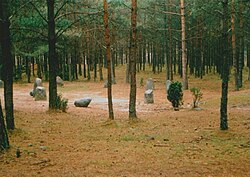Goths
- Goth can also stand for a member of the Goth subculture
The Goths (Gothic: ![]()
![]()
![]()
![]()
![]()
![]() , Gutans) were an East Germanic tribe that spoke the Gothic language. Jordanes, a scholar from the 6th century, wrote a summary of a 12-volume work by Cassiodorus about the Goths that is commonly called Getica.
, Gutans) were an East Germanic tribe that spoke the Gothic language. Jordanes, a scholar from the 6th century, wrote a summary of a 12-volume work by Cassiodorus about the Goths that is commonly called Getica.
Since the original work by Cassiodorius was lost, Getica is the only surviving contemporary account about the Goths. It states that the Goths left Scandinavia via Gotland and settled close to the mouth of the Vistula River, in present-day Poland. In the 3rd and the 4th centuries they settled Scythia, Dacia and parts of Moesia and Asia Minor, fought with the Roman Empire and later adopted Arianism (a form of Christianity).
In the 4th and the 5th centuries, they split into the Visigoths and the Ostrogoths. With that move, they established powerful successor-states to the Roman Empire in Italy and on the Iberian Peninsula (now Spain and Portugal). Traces of Gothic blood can be found in many people .[1]
Goths Media
Götaland* The island of Gotland* Wielbark culture in the early 3rd century* Chernyakhov culture, in the early 4th century* Roman Empire
A stone circle in the area of northern Poland occupied by the Wielbark culture, which is associated with the Goths
Oksywie culture and the early Wielbark culture* Expansion of the Wielbark culture* Przeworsk culture
Europe in AD 300, showing the distribution of the Goths near the Black Sea
Ring of Pietroassa, dated AD 250 to AD 400 and found in Pietroasele, Romania, features a Gothic language inscription in the Elder Futhark runic alphabet.
Gizur challenges the Huns by Peter Nicolai Arbo, 1886
Europe in AD 400, showing the distribution of the Goths in the aftermath of the Hunnic invasion
References
- ↑ Jordanes, Getica.










